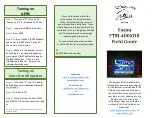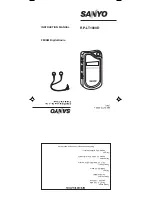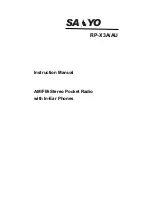
2
EN
3M™ PELTOR™ LiteCom Pro II Headset
Congratulations and thank you for choosing the 3M™
PELTOR™ LiteCom Pro II Headset. The LiteCom Pro II
headset is a hearing protector with a built-in, programmable
two-way communication radio, a level dependent function
for environmental listening, and a port to connect external
equipment.
The models described in this manual are certified as Intrinsically
Safe (IS). For further information and instructions on the use
within IS areas, please refer to the 3M™ PELTOR™ LiteCom
Pro II Headset IS Technical Data Sheet.
1. COMPONENTS
MT7H7F4010-**
(A:1) Headband (Stainless steel, Leather)
(A:2) Headband wire (stainless steel)
(A:3) Guide (POM)
(A:4) Ear cushion (PVC foil and PUR foam)
(A:5) Foam liner (PUR foam)
(A:6) Cup
(A:7) Environmental microphone
(A:8) Dynamic communications microphone
(A:9) Antenna
(A:10) External input/output
(A:11) Li-ion battery (rechargeable)
(A:12) On/Off/Mode button
(A:13) [+] button
(A:14) [–] button
(A:15) PTT button
MT7H7P3E4010-**
(A:16) Cup supporting arm (stainless steel)
MT7H7B4010-**
(A:17) Neckband
wire (stainless steel) (A:18) Neckband cover
(POX)
2. FITTING AND ADJUSTMENT
The noise reduction may be lower when eyeglasses, goggles
or respirator straps are worn between the sealing surface of the
earmuff cushions and the sides of the wearer’s head. For best
noise reduction, select eyeglasses or goggles that have thin,
flat temples or straps which will minimize interference with the
seal of the earmuff cushions. Pull long hair back to the extent
possible and remove other items that may degrade the earmuff
seal such as pencils, hats, jewelry or earbuds.
Do not bend and reshape the headband as this will cause a
loose fit and allow sound leakage.
2:1 Headband model (Fig. B)
(B:1) Expand the headband
(B:2) Slide out the cups and make sure that the cable is on the
outside of the headband.
(B:3) Place headset on top of your head and adjust the height
of the cups by sliding them up or down while holding the
headband in place. Each earmuff should be positioned so it
surrounds the ear entirely.
(B:4) The headband should be positioned across the top of
your head.
2:2 Hard hat attachment model (Fig. C)
(C:1) Insert the hard hat attachment in the slot on the hard hat
and snap it into place (C:2).
(C:3) Make sure that the cable is on the outside of the
headband.
(C:4) Usage position: Press the headband wires inwards
until you hear a click on both sides. Each cushion should be
positioned so it surrounds the ear entirely. Make sure that the
cups and the headband wires do not press on the edge of the
hard hat as this can cause noise leakage.
(C:5) Stand by position: Snap earmuffs out to allow ventilation.
(C:6) Avoid placing the cups against the hard hat as it will stress
on the hard hat attachment and prevent the earmuffs from
drying. When the hard hat is not in use, place the cups in work
mode.
Note: In Canada, users of hard hats combined with earmuffs
must refer to CSA Standard Z94.1 on industrial protective
headwear.
2:3 Neckband (Fig. D)
(D:1) Place the cups in position over the ears.
(D:2) Keep the headset in position and place the head strap on
top of your head and lock it tight in position.
(D:3) The head strap should be positioned across the top of your
head.
2:4 Microphone (Fig. E)
(E:1 & E:2) To maintain optimal audio quality and noise
cancelling performance, the communications microphone
should be positioned very close to your mouth (3mm or 1/8in).
2:5 Replacing the hard hat attachment plate (Fig. F)
The P3K hard hat attachment is included and fits a wide
selection of hard hats. If the P3K attachment does not fit on
your hard hat, contact 3M Technical Support or an authorized
dealer for alternative attachment plates. To remove the
attachment plate:
(F:1) Use a screwdriver to remove the screw holding the plate.
(F:2) Insert the new plate and tighten the screw.
3. USAGE/FUNCTIONS
3:1 Inserting and removing the battery
Insert the rechargeable battery in the battery compartment and
push down the clamp to lock it into place. The battery level is
indicated by a voice message in the headset upon startup. A
“low battery” message indicates only a few minutes of battery
life remains and the unit will automatically switch off. To remove
the battery, make sure the unit is powered off. Push the clamp
upwards to unlock the battery.
3:2 Recharging the battery
Make sure the unit is switched off. The battery can be charged
on the headset or it can be removed and charged separately.































